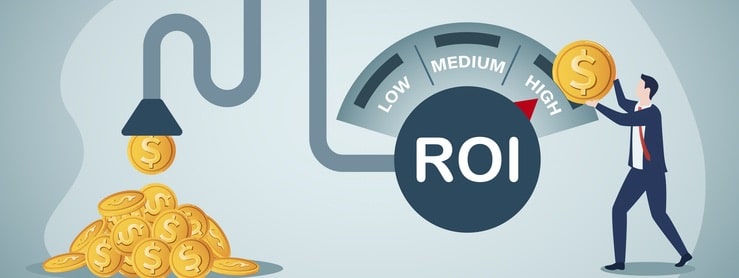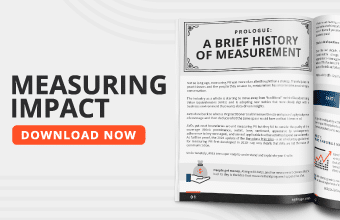Measuring PR success for your business is one of the fundamental steps you want to ensure as a PR professional or marketing manager. Tracking PR metrics lets you learn whether and how your PR efforts align with the business goals. So, what exactly do you measure here?
To be more precise, calculating PR ROI involves learning the impact of overall public relations strategy on sales and brand reputation. The benefits are manifold. For example, tracking how social media and media mentions contribute to these goals will help you develop effective future PR campaigns. Actionable insights for your PR team make managing the PR budget and PR strategy easier.
While measuring PR outcomes, you would want to focus on tangible outcomes and measurable objectives for metrics like conversions, engagement, and mentions from your social media channels. You’ll understand their monetary value and long-term contribution toward brand awareness and positive sentiment of your target market.
Let’s discover how you can ensure the best return on investment and campaign success through accurate PR measurement.
Key takeaways:
- Several best practices followed by the industry-leading PR professionals
- The right PR metrics to measure PR success
- The most effective tools and the ideal approach to combine with the right metrics for measuring PR ROI
- Case studies to help with the future success of your PR program.
Best practices
Let’s get familiar with the best practices for managing PR campaigns that ensure your PR efforts truly pay off and align with your business objectives.
1) Set objectives for PR efforts
Plotting your course on the map is the first step of a successful cross-country journey. The same goes for setting objectives for your PR campaigns. PR pros recommend that your campaign objective should be SMART—Specific, Measurable, Achievable, Relevant, Time-Bound. They help visualize where you want to go with campaign outcomes.
For instance, you might aim to boost your brand’s reputation within a specific target niche by enhancing media coverage in top-tier publications by 30 percent within the next quarter. This precise target directs your focus toward leveraging social media analytics and refining media relations strategies.
Also, a clear set of objectives helps you prepare for unexpected detours, like a PR crisis. You can effectively protect your brand’s reputation when things are wrong.
2) Have a baseline
Think of the baseline as your brand’s awareness level before launching the PR campaign. Then, you aim for a benchmark—where you want to be post-campaign. Using tools from social media platforms to media value assessments, compare your start and endpoints.
Here’s an example. Assume your brand is launching a custom hats lineup for the customers, and you want to learn how it contributes to brand awareness. With a clearly defined baseline, you can precisely measure the shift in consumer recognition and interest towards your new design lineup, learning its contribution to enhancing your brand’s profile.
3) Monitor and adjust PR campaigns
When you steer your PR sheep through the challenging seas, don’t forget to keep an eye on your compass or PR metrics. Adjust your sails with the shifting of winds. In terms of PR, regularly review how your campaign is performing on social media platforms and elsewhere. Learn what’s working and what’s not. PR experts use insights from PR ROI metrics and tools to tweak their approach consistently.
4) Communicate results effectively
Sharing your PR ROI results effectively can help reduce surprises and optimize the campaign performance in the long term. Clarity is the key when you share results with the stakeholders.
For example, you may start with digital media mentions and press releases, showing their reach. Highlight the spike in web traffic directly linked to PR efforts. Don’t forget to point out which media outlets featured your brand and how this exposure benefited you. In addition, analyze and report your social media interactions to showcase engagement levels.
Key metrics
Understanding the impact of your PR efforts comes down to knowing which metrics matter most. Let’s dive into the essentials.
1) Media mentions for enhanced PR value
Impressions and reach tell you how far your story has traveled. Think of impressions as the number of eyes on your press release or social media posts. Reach extends this idea, showing how many unique viewers have seen your content. High numbers here mean you’re getting noticed.
2) Website traffic from PR and media coverage
PR activities boost website visits and SEO efforts. When a press release or a media mention includes your website link, it directs readers to you. This referral traffic indicates that your PR is attracting interest and potential customers.
3) Engagement metrics
Likes, shares, comments, and mentions gauge how well your audience connects with your PR content. High engagement on social media posts indicates that people see and interact with your content. It’s a direct reflection of positive sentiment, contrasting the impact of negative sentiment.
4) Conversion rates and lead generation
Often, we view PR as visibility only. However, PR management involves actions, too. Effective PR prompts people to take the next step, from showing initial interest to becoming leads or customers. Therefore, a bump in conversion rates after a PR campaign signals success in turning viewers into buyers.
Tools
Leveraging the right tools is key to effectively measuring your PR campaigns’ success. Let’s round up the top tools:
- Media monitoring and analytics platforms: You can utilize top tools available in the market. They enable you to track media coverage and understand brand sentiment. You’ll get accurate sentiment analysis so that you know and can adjust the tone of conversations across various media outlets.
- Web analytics tools: Google Analytics, Ahrefs, and SEMrush dig into various site analytics and tell you exactly how well your PR efforts drive visitors to your site. The insights into user engagement and content effectiveness can be game-changing.
- CRM integration: Integrating PR data with customer relationship management (CRM) systems can allow for a deeper analysis of how PR activities contribute to lead generation and conversion. The process lets you track the journey from prospect to customer.
- Social media management tools: Platforms like Hootsuite, Sprout Social, SocialPilot, and Buffer help track audience engagement. You can see how your content performs and measure advertising value equivalency through social interactions.
These tools are indispensable for PR professionals aiming to generate leads, monitor brand sentiment, and optimize audience engagement.
Case studies
Here’s an inspiring example of a successful PR campaign: Bio-Oil’s “Every Body has a Skin Story.” Bio-Oil launched a multi-faceted campaign as a market leader aiming to strengthen its position. It combines PR, digital, and social media advertising alongside point-of-sale marketing. Utilizing the #myskinstory hashtag, the campaign developed a community through celebrity engagements, blogger stories, and charity partnerships. The goal was to achieve broad reach and deep engagement.
Media monitoring platforms also played a key role tracking media impressions and sentiment. The well-directed campaign exceeded its SMART objective with 568 shared stories and a reach of 13.9 million people.
What was the result? Bio-Oil saw a massive boost in brand loyalty and product sales. They surveyed Facebook users and 48.4 percent of the participants said they felt inspired to purchase by the campaign.
Conclusion
As we’ve covered the essentials of measuring your PR ROI, remember to always start with a SMART objective and set a baseline so that you know where to start and your expected outcome. Identifying the appropriate metrics helps you generate actionable insights on your PR campaign performance. Finally, don’t forget to utilize advanced analytics and campaign management tools for optimal results and real-time monitoring.








